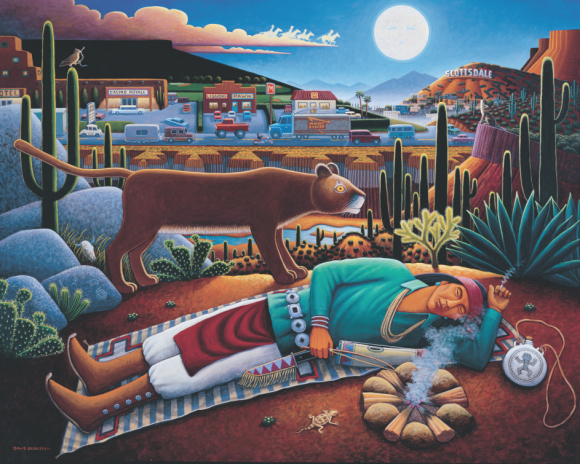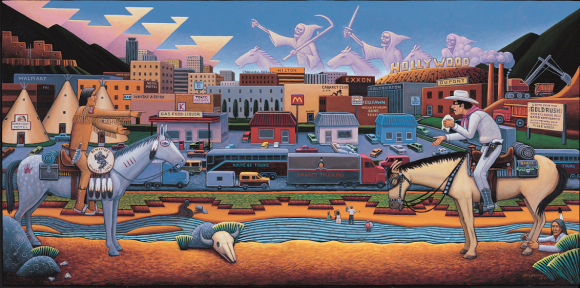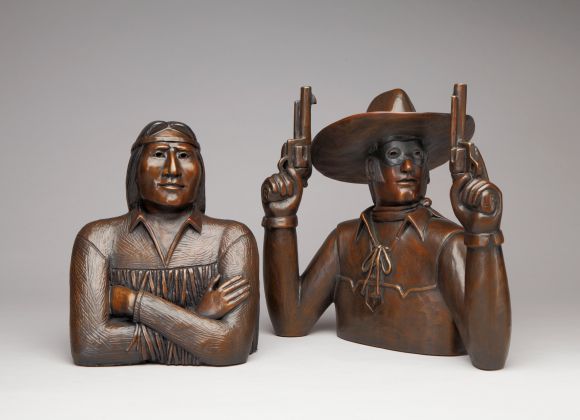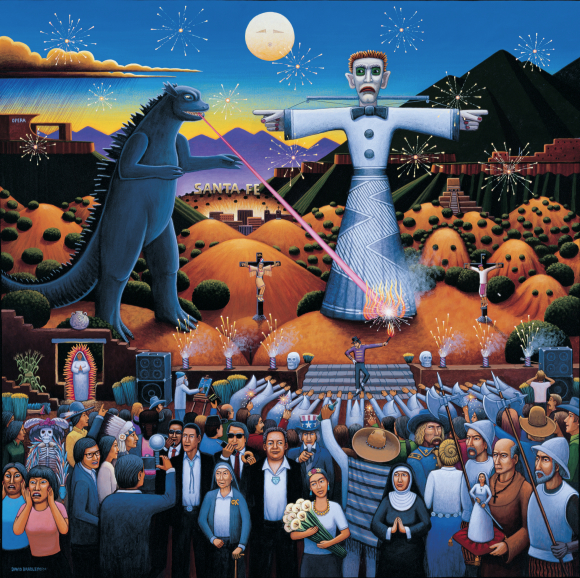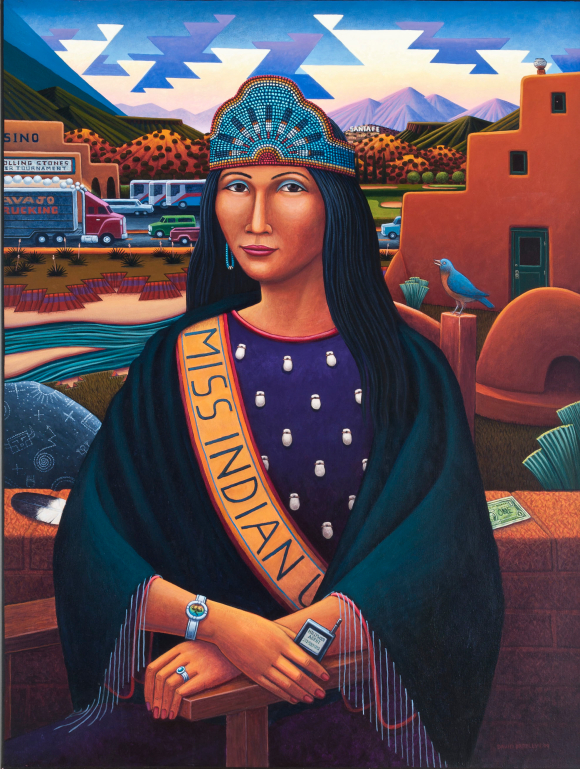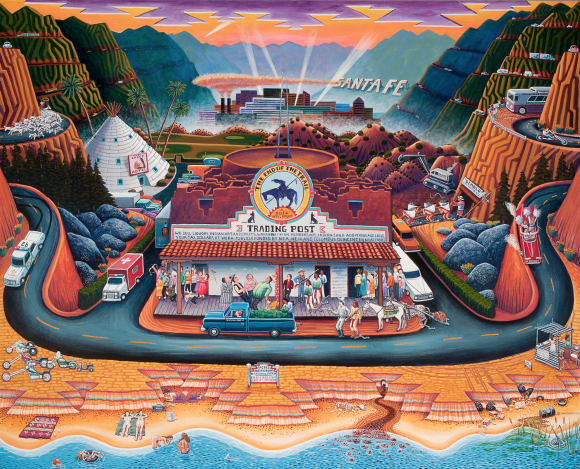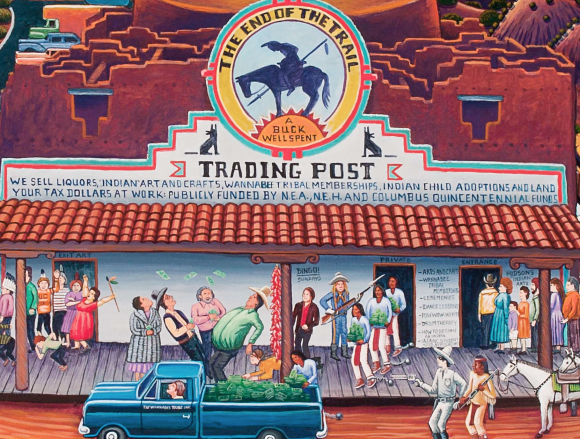 |
Canku Ota
|
 |
|
(Many Paths)
|
||
|
An Online Newsletter
Celebrating Native America
|
||
|
May 2015 - Volume 13
Number 5
|
||
|
|
||
|
David Bradley's Ironic
and Iconic Paintings Capture Indian Country
|
||
|
by Alex Jacobs - Indian
Country Today Media Network
|
||
|
credits:
unless otherwise specified: all images courtesy of Museum
of Indian Arts and Culture, Santa Fe, NM.
|
| David Bradley needed Santa Fe and Santa Fe needed David Bradley.
He could’ve gone anywhere, any place in Indian country, any city
or big art market town in the nation but sometimes you can’t
pass up the perfect fit—even if you're making it fit whether
they like it or not. And everyone liked it, Natives and non-Natives
loved his humor and criticisms, if you thought you were somebody then
you should be in one of his paintings. David’s paintings are
narratives, a welcome to and a tour through… Indian country.
Valerie Verzuh, who curated the show and edited the excellent catalog/book
for MIAC—the Museum of Indian Art and Culture—says that
in Bradley's creative world, there is no exact time, no beginning,
no end, all time and all places come together in his artwork. As you
view his pieces, anyone and everyone, all our Native heroes are present,
all supporters, and all antagonists are there to work out what is
real and what is imaginary.
The imaginary is what ties this all together, because the critique of the Native place in American history and society is about the struggle people have with our realities versus the imaginary, the fantasies, and the stereotypes. Non-Natives (and Natives too) have these narratives ingrained and embedded in our thinking; so as Bucky Fuller said, you can’t change the present with the same paradigm, so change the paradigm. That’s what Bradley does, he creates and draws you into these new and different narratives where you get to see the Native side of things real, things made up, and things as they should be. Bradley says his art "portrays human conditions and personal relationships that would be too controversial in another form." He is hard, cutting, biting, but also gentle, tender and funny; he uses modern mixed media to tell tragic tales of Native History—but the paintings take you mystical places that make sense out of absurdity.
The exhibit and book are divided into personal experiences, political and social activism, the Santa Fe Art scene in his End of the Trail imagery, and the homages to iconic art masterpieces in which he deconstructs their meanings then reconstructs them into Native narratives. Other artists have also utilized this, copying the masters, but you always go back to see how David did it as a reference. "My art suggests and comments on situations but doesn’t resolve them," he says. "Each viewer brings something of their own life experiences to it, and their interpretations are often as valid as mine." There are keys and clues, images and characters that he uses as a personal vocabulary: Tonto and the Lone Ranger, potsherds and petroglyphs, coyote, money, feathers, blue birds and electrical plugs.
Bradley was born to a Minnesota Chippewa mother and an Anglo father in 1954; at a young age he and his sister were adopted out to an Anglo family and he did not re-connect with his family and people until his early 20’s. Always interested in art and music, he joined the Peace Corps, going to the Dominican Republic and Guatemala from 1975-77. He graduated from the Institute of American Indian Art in 1979 and got his MFA from the College of Santa Fe in 1980. He joined the Elaine Horwitch Galleries, which was the center of contemporary art back in that heyday of that Santa Fe art scene.
Because of his background, tribal and cultural identity became important to him, as did the political struggle to fight for all Native people and their causes. He used AIM, Wounded Knee, Bering Straits Theory, Native Treaties and Indian stereotypes in his collages, paintings and sculptures, all the usual suspects and heroes. Many artists today were influenced by how Bradley used these political images. When he got to Santa Fe, he ran into some opposition from wannabe Indian Artists and their galleries and he led several fights against all manner of exploitation, commercialization and commodification.
His critique of Santa Fe and the Native Art scene came from his love of the land and its people. In his statement he said he that “New Mexico had an immediate impact on me and I knew I would live the rest of my life here.” He married into a Jemez Pueblo family and his family now lives near the little art/hippie/biker town of Madrid, outside Santa Fe. Every time a political issue would surface, all the Indian artists would say, “Where’s Bradley?” and the more he became a no-show, we all thought he was “mellowing out”. As it turns out, he revealed that he has amyotrophic lateral sclerosis (ALS), which has affected his movement, his work and life. But he attended the opening to meet all his old friends, clients and supporters, and he has new work as well. The piece that says it all is, “Pueblo Feast Day 1984/Full Circle 2014”, a repeat of an early image in the same style, but now it just takes him longer to paint. The guests sitting at the Pueblo Feast table include American Culture icons and they are invited into Indian Country to sit and share as equals, but they are visitors, a minority inside Indian Country, not in charge and beholden to the Natives as guests.
There are close to 40 pieces in the show and many, many more in the catalog/book. If you’ve never seen Bradley’s work it’s quite a visual treat, colors and lines vibrating off the walls. They’re all there, the Sleeping Indian, Super Indian, American Indian Gothic, Pow Wow Princess, Indian Market, Godzilla vs Zozobra, El Farol nightclub, the End of the Santa Fe Trail, Mankato and Wounded Knee, all the Indian artists, art collectors, gallery owners, local characters and legends. Even the people he critiques want to be in the paintings, everyone wanted to be in one, as did the collectors and patrons who commissioned him to commemorate their lives or accomplishments. There are also sculptures, mostly bronzes and the best are of women, love and tenderness. MIAC has done an excellent job in honoring David Bradley and his contributions to Santa Fe and Native Art. It may be a legacy show and the book will be around a long time, but David is still working, still painting, still funny, still pointed, still ironic, still iconic.
|
||||||||||||||||||||||||
|
|
||
|
|
||
| Canku Ota is a free Newsletter celebrating Native America, its traditions and accomplishments . We do not provide subscriber or visitor names to anyone. Some articles presented in Canku Ota may contain copyright material. We have received appropriate permissions for republishing any articles. Material appearing here is distributed without profit or monetary gain to those who have expressed an interest. This is in accordance with Title 17 U.S.C. Section 107. | ||
|
Canku Ota is a copyright ©
2000 - 2015 of Vicki Williams Barry and Paul Barry.
|
||
 |
 |
|
|
The "Canku
Ota - A Newsletter Celebrating Native America" web site and
its design is the
|
||
|
Copyright ©
1999 - 2015 of Paul C. Barry.
|
||
|
All Rights Reserved.
|
||
